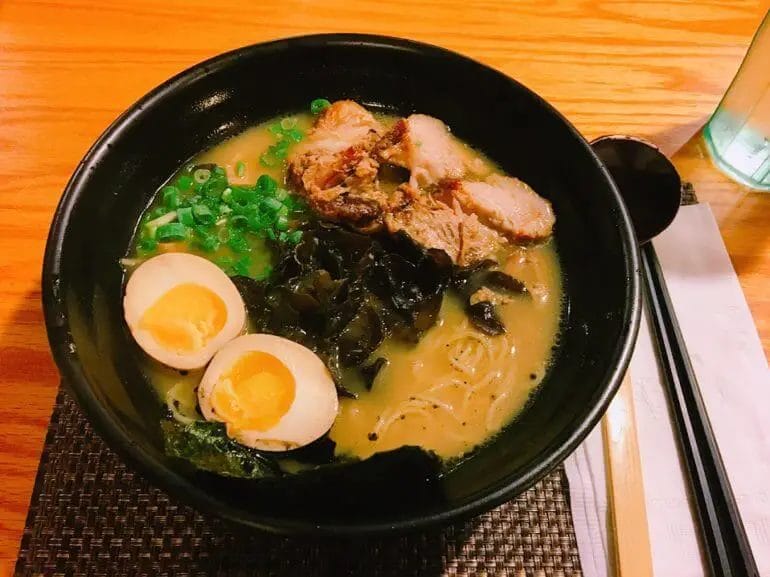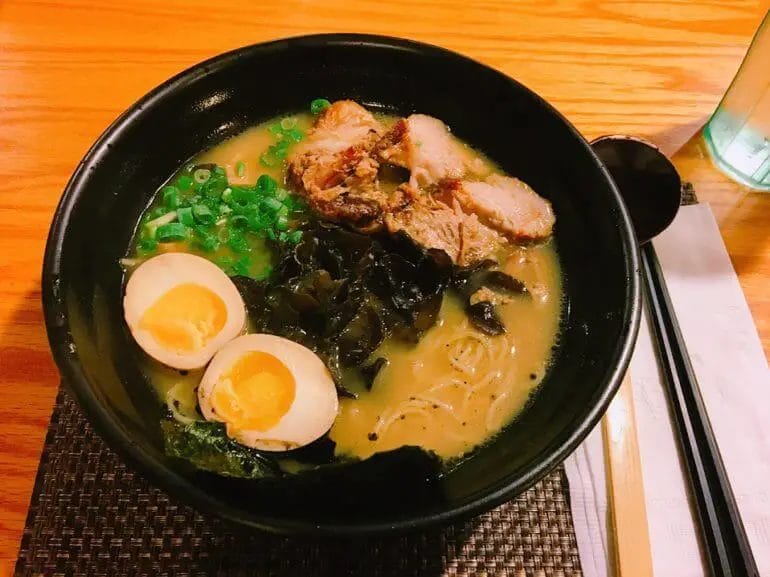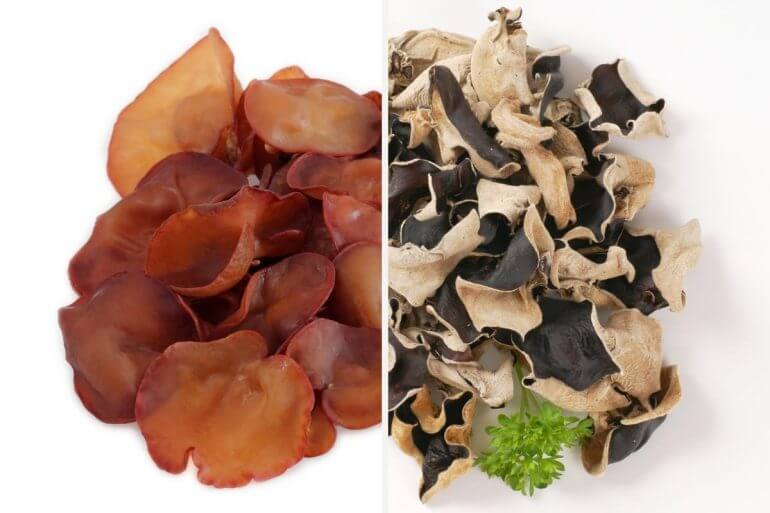Wood ear, also known as black fungus or cloud ear mushroom, is a popular ingredient in ramen. It is a type of edible fungus with a unique texture and mild flavor.
Wood ear mushrooms are often used in Asian cuisine for their crunchy and gelatinous texture, which adds a delightful chewiness to dishes like ramen.

In ramen, wood ear mushrooms are typically rehydrated and added as a topping, providing a contrasting texture and earthy taste to the rich broth and other ingredients.
These mushrooms are not only delicious but also offer several health benefits, including being a good source of iron, fiber, and antioxidants.
If you’re a fan of ramen, don’t miss out on the delightful addition of wood ear mushrooms, which bring a unique and satisfying element to the dish.

Culinary uses of wood ear in ramen dishes
Wood ear, also known as black fungus or cloud ear, is a popular ingredient in many Asian cuisines, including ramen dishes. The unique texture and earthy flavor of wood ear make it a perfect addition to various ramen recipes. In this section, we will explore the culinary uses of wood ear in ramen dishes and how it enhances the overall taste and presentation of the dish.
1. Texture and Visual Appeal
One of the reasons wood ear is used in ramen dishes is its distinctive texture. When cooked, wood ear becomes soft and slightly chewy, adding a pleasant mouthfeel to the ramen. Its velvety smooth surface also adds visual appeal to the dish, creating an interesting contrast with the other ingredients.
2. Umami Flavor Enhancer
Wood ear has a mild earthy flavor that blends well with the rich broth of ramen. It acts as a natural umami enhancer, intensifying the savory taste of the dish. The subtle taste of wood ear adds depth and complexity to the overall flavor profile, making the ramen more satisfying and enjoyable.
3. Nutritional Benefits
Aside from its culinary uses, wood ear also offers various health benefits. It is a good source of dietary fiber, which aids digestion and promotes a healthy gut. Wood ear is also low in calories and fat, making it a nutritious addition to ramen dishes without compromising on taste.
4. Versatile Ingredient
Wood ear can be used in different ways to enhance the ramen experience. It can be added to the broth during cooking to infuse its flavor throughout the dish. Alternatively, it can be rehydrated and sliced into thin strips to be used as a garnish, providing a delightful crunch and visual appeal to the ramen bowl.
5. Pairing with Other Ingredients
Wood ear blends well with a variety of ingredients commonly found in ramen dishes. It complements the flavors of vegetables like bok choy, bean sprouts, and scallions. Additionally, it pairs well with meats such as pork belly, chicken, or beef, adding another layer of complexity to the dish.
In summary, wood ear is a versatile and nutritious ingredient that enhances the taste, texture, and visual appeal of ramen dishes. Its unique texture, umami flavor, and health benefits make it a popular choice among chefs and home cooks alike. Whether used in the broth or as a garnish, wood ear adds depth and complexity to the overall ramen experience. So, next time you enjoy a bowl of ramen, be sure to savor the delightful addition of wood ear.

How to Properly Prepare and Cook Wood Ear for Ramen
Wood ear mushrooms, also known as black fungus or cloud ear fungus, are a popular ingredient in many Asian dishes, including ramen. These mushrooms have a unique texture and add a delightful crunchiness to the dish. However, preparing and cooking wood ear mushrooms may seem intimidating if you have never done it before. In this section, we will guide you through the process of properly preparing and cooking wood ear mushrooms for your homemade ramen.
1. Choosing and Cleaning Wood Ear Mushrooms
When selecting wood ear mushrooms, look for ones that are fresh, plump, and free from any signs of discoloration or mold. You can find them in most Asian grocery stores, either fresh or dried. If using dried mushrooms, soak them in warm water for about 30 minutes until they become soft and pliable.
To clean the mushrooms, gently rinse them under cold water to remove any dirt or debris. If there are any tough stems, trim them off using a pair of kitchen scissors. It is important to note that wood ear mushrooms have a unique texture that might feel a bit rubbery even after cooking, so do not be alarmed.
2. Slicing the Wood Ear Mushrooms
After cleaning the wood ear mushrooms, it’s time to slice them. Take a handful of mushrooms and stack them on top of each other. Using a sharp knife, make thin, even slices. You can choose to slice them into strips or smaller pieces, depending on your preference. Slicing the mushrooms helps to evenly distribute their texture and flavor throughout the ramen.
3. Preparing the Seasonings
Before cooking the wood ear mushrooms, it’s important to prepare the seasonings for your ramen. This may include soy sauce, mirin, garlic, ginger, or any other flavoring you prefer. You can also prepare a simple broth using vegetable or chicken stock, adding depth of flavor to your ramen.
4. Cooking the Wood Ear Mushrooms
To cook the wood ear mushrooms, heat a teaspoon of cooking oil in a skillet or wok over medium heat. Add the sliced mushrooms and stir-fry them for about 2-3 minutes until they become slightly softened and fragrant. You can season them with a pinch of salt and black pepper to enhance their flavor.
Alternatively, you can also blanch the wood ear mushrooms in boiling water for about 1-2 minutes until they become tender. Drain them and rinse with cold water to stop the cooking process.
5. Adding Wood Ear Mushrooms to Ramen
Once the wood ear mushrooms are cooked, you can add them to your prepared ramen. Whether you are making a traditional ramen soup or a stir-fried noodle dish, the wood ear mushrooms will complement the flavors and add a satisfying crunch. Remember to adjust the seasoning according to your taste preferences.
Wood ear mushrooms are a wonderful addition to any ramen dish. By following these steps, you can properly prepare and cook wood ear mushrooms to elevate the taste and texture of your homemade ramen. Enjoy!

Varieties of Wood Ear Used in Different Types of Ramen
Wood ear, also known as cloud ear or black fungus, is a common ingredient used in Asian cuisines, including ramen. It is valued for its unique texture and earthy flavor, which adds depth to the dish. In this section, we will explore the different varieties of wood ear that are commonly used in various types of ramen.
1. Auricularia polytricha
Auricularia polytricha, also known as black wood ear or black fungus, is one of the most popular varieties of wood ear used in ramen. It has a dark, almost black color and a slightly rubbery texture. It is often rehydrated before being added to the broth, where it absorbs the flavors and releases a subtle umami taste.
This variety of wood ear is commonly found in miso ramen, a rich and flavorful ramen broth made with fermented soybean paste. The black wood ear adds a visually appealing contrast to the light-colored broth and provides a pleasant chewiness to the dish.
2. Auricularia auricula-judae
Auricularia auricula-judae, commonly known as Jew’s ear or jelly ear, is another variety of wood ear used in ramen. It has a translucent appearance and a softer texture compared to the black wood ear. It is often sliced thinly and added to the ramen as a garnish.
This variety of wood ear is commonly found in shoyu ramen, a soy sauce-based ramen broth known for its savory and slightly salty flavor. The Jew’s ear adds a delicate crunch and visual appeal to the bowl of ramen, complementing the other ingredients.
3. Auricularia cornea
Auricularia cornea, also known as white wood ear, is a less commonly used variety of wood ear in ramen. It has a pale white color and a tender texture. It is often used as a substitute for the black wood ear or Jew’s ear, depending on availability and personal preference.
This variety of wood ear can be found in various types of ramen, including tonkotsu ramen, a rich and creamy pork bone broth. The white wood ear adds a subtle taste and a tender bite to the robust flavors of the tonkotsu broth.
4. Other Varieties
In addition to the aforementioned varieties, there are other types of wood ear that are occasionally used in ramen. These include Auricularia polytricha var. major, which has a larger and thicker texture, and Auricularia delicata, which has a milder flavor.
The choice of wood ear used in ramen can vary based on regional preferences and the chef’s creative vision. Some ramen establishments may even use a combination of different varieties to create a unique and balanced flavor profile.
Summary
Wood ear is a versatile ingredient that adds texture and flavor to different types of ramen. The varieties of wood ear commonly used in ramen include Auricularia polytricha, Auricularia auricula-judae, and Auricularia cornea, each offering a distinct taste and texture. Other varieties such as Auricularia polytricha var. major and Auricularia delicata may also be used in certain ramen preparations. The choice of wood ear depends on the type of ramen and the desired flavor profile. Whether it’s the chewiness of black wood ear in miso ramen or the delicate crunch of Jew’s ear in shoyu ramen, wood ear adds a unique element to the overall ramen experience.
The History and Cultural Significance of Wood Ear in Ramen Cuisine
Ramen, a popular Japanese dish consisting of noodles in a flavorful broth, has gained worldwide recognition for its delicious taste and versatility. While the basic components of ramen include noodles, broth, and toppings, one particular ingredient that plays a significant role in its flavor and texture is wood ear.
Wood ear, scientifically known as Auricularia auricula-judae, is a type of edible fungus commonly found in Asian cuisine. It has a distinctive appearance, with its thin, rubbery, and ear-shaped cap, which gives it its name. In ramen, wood ear is typically used as a topping, adding both flavor and visual appeal to the dish.
The history of wood ear in ramen can be traced back to its Chinese origins. Ramen itself is believed to have been introduced to Japan from China during the late 19th century. Chinese immigrants brought their culinary traditions with them, including the use of wood ear in their noodle dishes.
Wood ear has a long history in Chinese cuisine, where it is valued for its medicinal properties and unique texture. It is commonly used in soups, stir-fries, and hot pot dishes. When Chinese ramen, known as “lamian,” made its way to Japan, wood ear became a natural addition to the evolving ramen culture.
Wood ear not only enhances the taste and appearance of ramen but also adds a delightful chewy texture. Its slightly crunchy yet jelly-like consistency provides a satisfying mouthfeel and contrasts with the softness of the noodles and richness of the broth. This textural element is highly valued in ramen, as it adds complexity and depth to the overall eating experience.
Aside from its culinary benefits, wood ear holds cultural significance in ramen cuisine. Many ramen shops take pride in their unique toppings and use of traditional ingredients. Including wood ear in the ramen bowl is a nod to the historical origins of the dish, connecting it to its Chinese heritage.
Moreover, wood ear is also associated with various health benefits. It is known to be rich in dietary fiber, low in calories, and a good source of vitamins and minerals. This makes it a desirable ingredient for health-conscious individuals who still want to enjoy a flavorful and satisfying bowl of ramen.
In summary, wood ear plays a vital role in the history, flavor, and cultural significance of ramen cuisine. Its origins in Chinese culinary traditions have shaped the evolving ramen culture in Japan and beyond. The unique texture and visual appeal it brings to the dish, along with its health benefits, make it a beloved ingredient in ramen bowls worldwide. So, the next time you savor a bowl of ramen, take a moment to appreciate the humble wood ear topping that adds so much to this beloved dish.
FAQs
What is wood ear in ramen?
Wood ear, also known as black fungus, is a type of mushroom commonly used in Asian cuisine, including ramen. It has a chewy texture and a mild earthy flavor. Wood ear adds a unique texture and visual appeal to the dish, complementing the other ingredients in the ramen bowl.
Conclusion:
In conclusion, wood ear in ramen adds a unique texture and flavor to the dish. Its rubbery yet crunchy texture creates an interesting contrast with the soft noodles and savory broth. The wood ear mushroom also absorbs the flavors of the broth, enhancing the overall taste experience. Additionally, wood ear mushrooms are rich in nutrients, such as iron and fiber, making them a healthy addition to your ramen bowl. Whether you’re a ramen enthusiast or a curious foodie, don’t miss the opportunity to try ramen with wood ear mushrooms for a delightful and satisfying meal.
